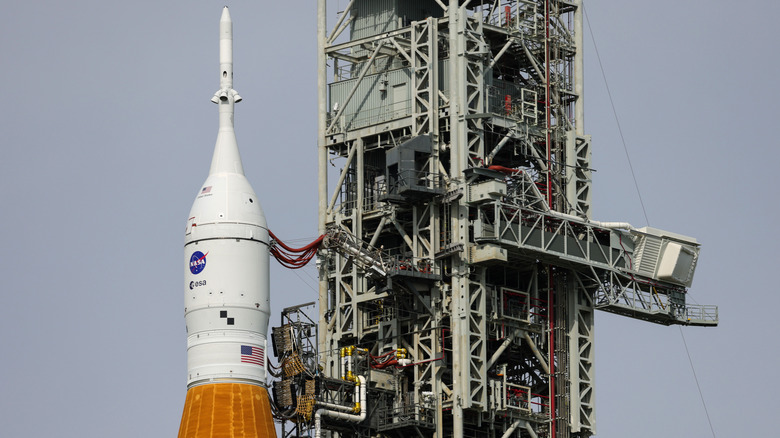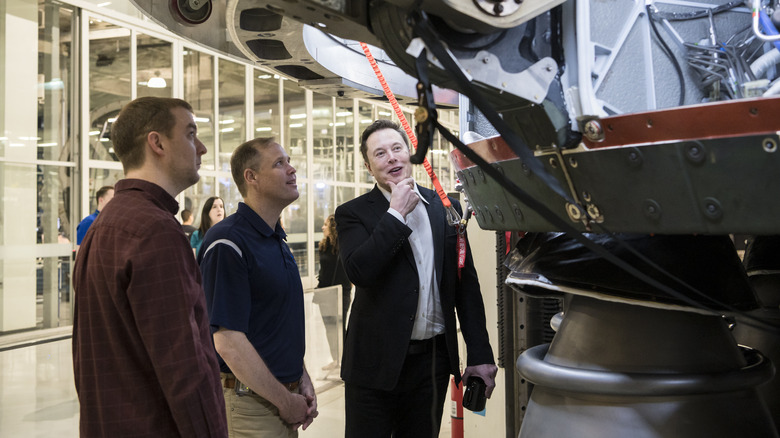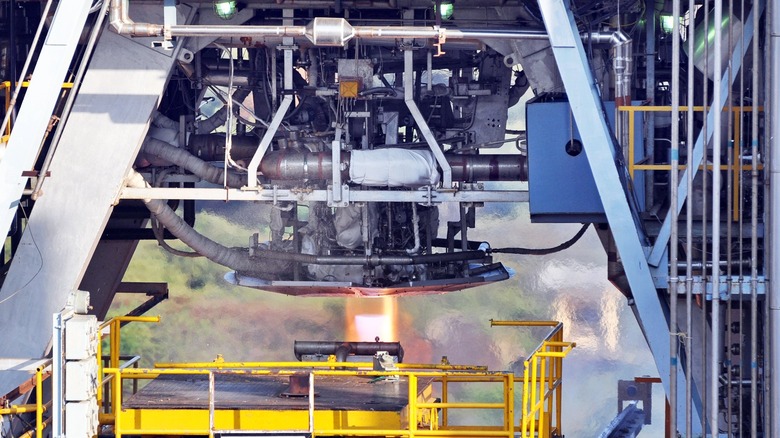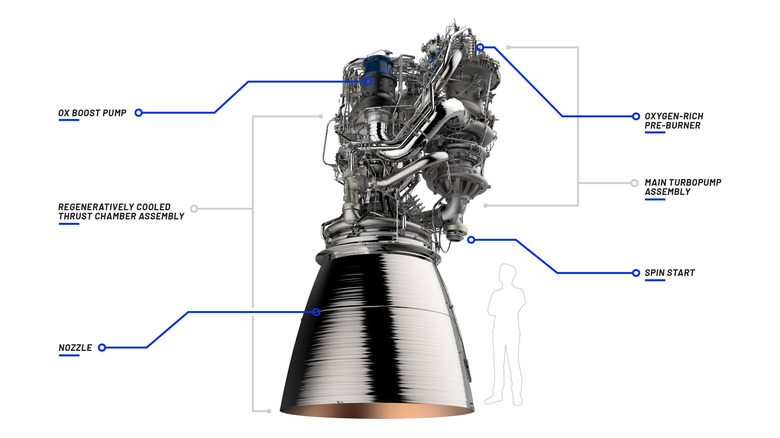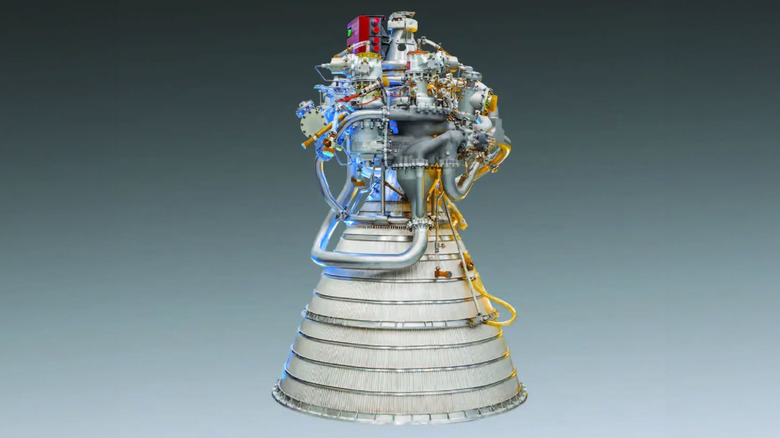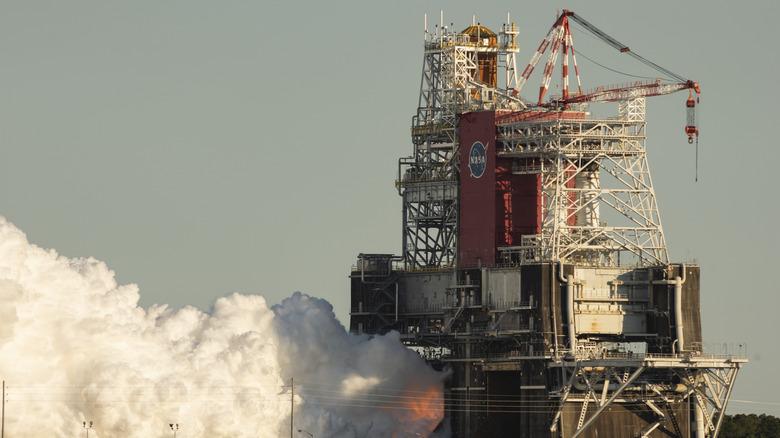5 Of The Most Powerful Engines Propelling Space Exploration
Out of all humankind's amazing feats, perhaps nothing is more impressive than our ability to launch into outer space. Though the first-ever space flight occurred in 1957 when the Soviet Union launched Sputnik 1 into space, rocket engine technology was already being tinkered with in previous decades. Examples like the Bell rocket-propelled X-1 "Glamorous Glennis" airplane, the first aircraft to break the sound barrier in 1947, show that the development of space exploration technology occurred decades before NASA astronauts would land on the moon.
Space exploration has come a long way since the '50s and '60s, with new, more effective engines powering the spacecraft exploring the borders of our solar system and beyond. With this expansion of knowledge also comes the ability for more countries to try to navigate space, with a host of private spaceflight companies like SpaceX, Blue Origin, and Virgin Galactic also taking center stage in the space exploration conversation.
That said, not all of today's most powerful rockets are actually propelled by the same engines. In fact, there are several types of engines currently in use powering today's modern rocket ships.
Merlin 1D
Elon Musk's SpaceX program has been the subject of some controversy and missteps, recently coming under fire for the Super Heavy Booster platform and its potential effects on the environment. That said, from a technological and space exploration point of view, SpaceX has been one of the most successful private companies to ever take on spaceflight. Its Falcon rockets have launched a multitude of Starlink satellites, with the Merlin 1D engine powering the payload into space.
On the Falcon Heavy, 27 Merlin 1D engines each produce 63.5 tonnes of thrust at sea level. Utilizing liquid-propellant, the Merlin has a turbopump design with a single shaft that contains the fuel pump, liquid oxygen (LOX) pump, and turbine. Rather than utilizing the staged combustion cycle found in other rocket engines, the Merlin uses a gas generator cycle, with a pintle injector providing combustion stability.
Ever Since the Merlin 1A was used in 2006, engines from SpaceX have seen steady improvements. The Merlin 1D has been used as recently as January 23, 2024, when a Falcon 9 rocket launched 22 Starlink satellites into low-Earth orbit.
CE-20
The CE-20 cryogenic engine was developed by the Indian Space Research Organization and its subsidiary development arm, the Liquid Propulsion Systems Centre. The CE-20 was used in the Chandrayaan-3 lunar mission, India's space mission launched in July 2023, which demonstrated the country's ability to land on the Moon's surface.
Cryogenic engines typically use a combination of LOX as the oxidizer and liquid hydrogen (LH2) as fuel, with the CE-20 having the capacity to hold over 27,000 kg of fuel. Cryogenic fuels enable the CE-20 to achieve the lift necessary to deliver payloads to space and are used in the rocket's upper stages. The CE-20 has various components, including a thrust chamber, LOX and LH2 turbo pumps, regulators, fuel injectors, a gas generator, and other high-tech components that help provide additional power to the Indian rockets.
The first flight using the CE-20 occurred in June 2017, with the engine powering the upper stages of the Geosynchronous Satellite Launch Vehicle Mark III, a 640-tonne rocket used by the Indian Space Research Organization. Later, in 2023, the CE-20 would be successfully used in the Chandrayaan-3 mission, marking a momentous moment in India's history.
BE-4
Blue Origin, the space exploration company founded by Jeff Bezos, uses the BE-4 in its spacecraft, an oxygen-rich, liquefied natural gas (LNG) staged combustion engine that's able to produce 2,400 kilonewtons of lift at sea level. Unlike other rocket engines, which often utilize a highly refined version of kerosene called Rocket Propellant-1 or Refined Petroleum-1 (RP-1), Blue Origin opted for LNG for its cleaner combustion characteristics.
The Blue Origin BE-4 is used as the United Launch Alliance's (ULA) Vulcan rocket's main engine and also powers New Glenn's reusable booster. The ULA's Vulcan Centaur launched its first flight on January 8, 2024, from Cape Canaveral, Florida, and two BE-4 engines helped launch the rocket into space with nearly two million pounds of thrust. Though issues with the moon lander prevented it from making contact with the lunar surface, it proved the ability of the BE-4 on a modern rocket.
The BE-4 also powers the booster for Blue Origin's New Glenn heavy-lift rocket. New Glenn stands 322 feet tall and can haul 50 tons of material into Earth's low orbit. The rocket will be powered by seven BE-4 engines to provide the additional thrust required for the heavier rocket. The scheduled launch for the New Glenn is currently August 2024.
RL10
The RL10 is one of the oldest rocket engines still used to this day, making its first flight all the way back in 1959. First developed by Pratt & Whitney in the late 1950s but now manufactured by Space Launch System and Aerojet Rocketdyne, more than 500 RL10 engines have blasted into space. It's been successfully used in a variety of space missions, including the Saturn S-IV and Atlas V, with the latest iterations being used in the upcoming Artemis space missions that aim to send Americans back to the Moon on the Orion spacecraft.
The RL10, like the CE-20, is used for the upper stages in rockets. Along with the BE-4, the RL10 is also used in the Vulcan Centaur rocket. The RL10 was the first rocket engine to use high-energy liquid hydrogen, with six of the engines generating 90,000 pounds of thrust to lift the Saturn S-IV in 1963.
The newer variation of the engine that will be used in the Artemis missions is the RL10C-3, which can produce 24,340 pounds of thrust individually.
RS-25
The RS-25 powers NASA's Space Launch System (SLS), the most powerful rocket in the world. With 416,300 pounds of thrust at sea level, it serves as the main engine for the core stage of the SLS and has been used successfully in 135 missions.
Designed originally by Rocketdyne, RS-25 engines are now constructed by the modern iteration of the company, Aerojet Rocketdyne, owned by L3Harris Technologies. The RS-25 is a staged-combustion engine powered by liquid hydrogen and liquid oxygen and can hold 700,000 gallons of fuel. Massive in size, each engine measures 14 by 8 feet and weighs 7,800 pounds. When operational, the engines burn at over 6,000 degrees Fahrenheit.
Though the first space shuttle launch utilizing the RS-25 was with the STS-1 in 1981, the engine has seen substantial upgrades over the years, increasing its operational thrust levels. The four RS-25 engines included as part of the SLS in the NASA Artemis missions will generate over two million pounds of thrust to send NASA's Orion spacecraft into space.
